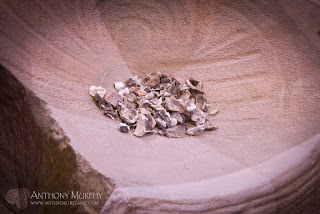For a while, I've been wondering about how the small human bone fragments that have been found in some Irish passage-tombs came to be in such a fragmented condition. In terms of the unburnt bone human fragments found during the O'Kelly excavations at Newgrange, "apart from some complete hand and foot bones, all human specimens consisted of small fragments". (O'Kelly, Newgrange: Archaeology, Art & Legend, Thames & Hudson, 1982).
 |
| Replica of basin stone from Knowth's eastern chamber with bone fragments. |
There were a total of 750 unidentifiable fragments. The fragmented remains of dozens of individuals were found in the chambers of nearby Knowth. Layers of fragmented remains were found in the passage and chamber of Fourknocks. So how do human bones - those that are not cremated - become so fragmented?
Searching through my extensive archive of research material, I found an interesting article from the Sunday Times from July 2003. Eileen Murphy of Queen's University Belfast had studied Irish neolithic bones and found that our early ancestors had dismembered and defleshed their dead. Murphy had worked on the excavation of graves in Aymyrlyg graves in Siberia, Russia.
There she learnt to look for the tell-tale signs of what is thought to have been an ancient religious practice - short, fine scraping marks on the bone and cuts where tendons and ligaments were joined.The researchers from Queen's made the findings when examining bones from the 4,000-year-old Millin Bay tomb in County Down, and the discoveries mirrored those found by Swedish archaeologists at Carrowmore in Co. Sligo. The Sunday Times article described how body parts, notably skulls, are thought to have been kept on display for religious purposes.
"After studying the dismembered and refleshed Russian remains, I decided to have another look at Irish neolithic bones. It is something that has been overlooked before and will now require a reassessment of our understanding of these ancient burial sites.
Gabriel Cooney, professor of archaeology at University College Dublin, told the newspaper:
In these tombs you rarely find single skeletons, but rather groups of cremated remains. In this way these neolithic people would seem to have been creating a new identity from their treatment of the dead. You also find different parts of the body treated in different ways, such as unburnt parts of the skull in with cremated remains. This would point to dismembering of the corpses.
 |
| Were the Brugh na Bóinne bones defleshed by humans or by the process of natural outdoor excarnation? |
A chance finding of a bone fragment in a cave at Knocknarea in Sligo led to the discovery of more bone fragments belonging to an adult and a child which may have been evidence of cave excarnation. Radiocarbon dating put the age of the bones at over 5,000 years old. It is thought that the process of excarnation in a cave took much longer - perhaps up to two years - but eventually the deceased's relatives would come back to collect the bones for burial elsewhere. In the case of Knocknarea, this burial might have taken place in one of several monuments on the top of the mountain.
We can imagine, therefore, that Stone Age people in Sligo between 5,000 and 5,500 years ago carried the corpses of their dead up the mountain. After an arduous climb, they then squeezed through the narrow cave entrance, and laid the dead person on the cave floor. (Source)
What's also interesting in Ireland is that osteoarchaeological analysis has revealed an absence of animal scavenging marks, suggesting that the entrance to the excarnation caves was sealed during the process of soft tissue decomposition.
This reveals a conscious decision not to speed up decomposition . . . By creating a protective environment in which excarnation took place undisturbed, people controlled the process, pace and space. The living may have sought to observe the slow and gradual disintegration that was taking place inside a cave. The underground was therefore a place of transformation, which in turn transformed caves as places. It may have been in caves that the journey into the spirit world commenced. (Dowd, Marion, The Archaeology of Caves in Ireland, Oxbow Books, 2015, p. 106)
 |
| Flint blades from Newgrange - were these used in the defleshing process? |


Boiling was used in later times to deflesh. It might have been used in the Boyne Valley. Also, the round stone balls found near basins in cairns could have been used to crush long bones that weren't consumed by flames.
ReplyDeleteExcavations on the route of the A1 at Loch Bricrann (Loughbrickland) in county Down (named after Bricriú) found post-holes gathered in fours. These have been interpreted as being supports for sky-burial platforms.
ReplyDeleteThanks Brendan. I must follow this up. Cheers.
Delete